Essay on Personal Leadership Approach - Leadership MGT301
VerifiedAdded on 2023/04/04
|8
|2004
|342
Essay
AI Summary
This essay presents a self-reflection on a personal approach to leadership, utilizing frameworks like self-perception theory, cognitive dissonance theory, and self-presentation theory. The author analyzes their self-concept through the lenses of self-esteem, self-efficacy, and personal experiences, particularly within family and social contexts. The reflection highlights the importance of self-awareness, confidence, and the impact of environmental factors on shaping individual leadership styles. The essay concludes that a blend of mental originations, character traits, and personal conceptions is crucial for developing effective leadership qualities. Desklib provides students access to similar solved assignments and resources for academic enrichment.
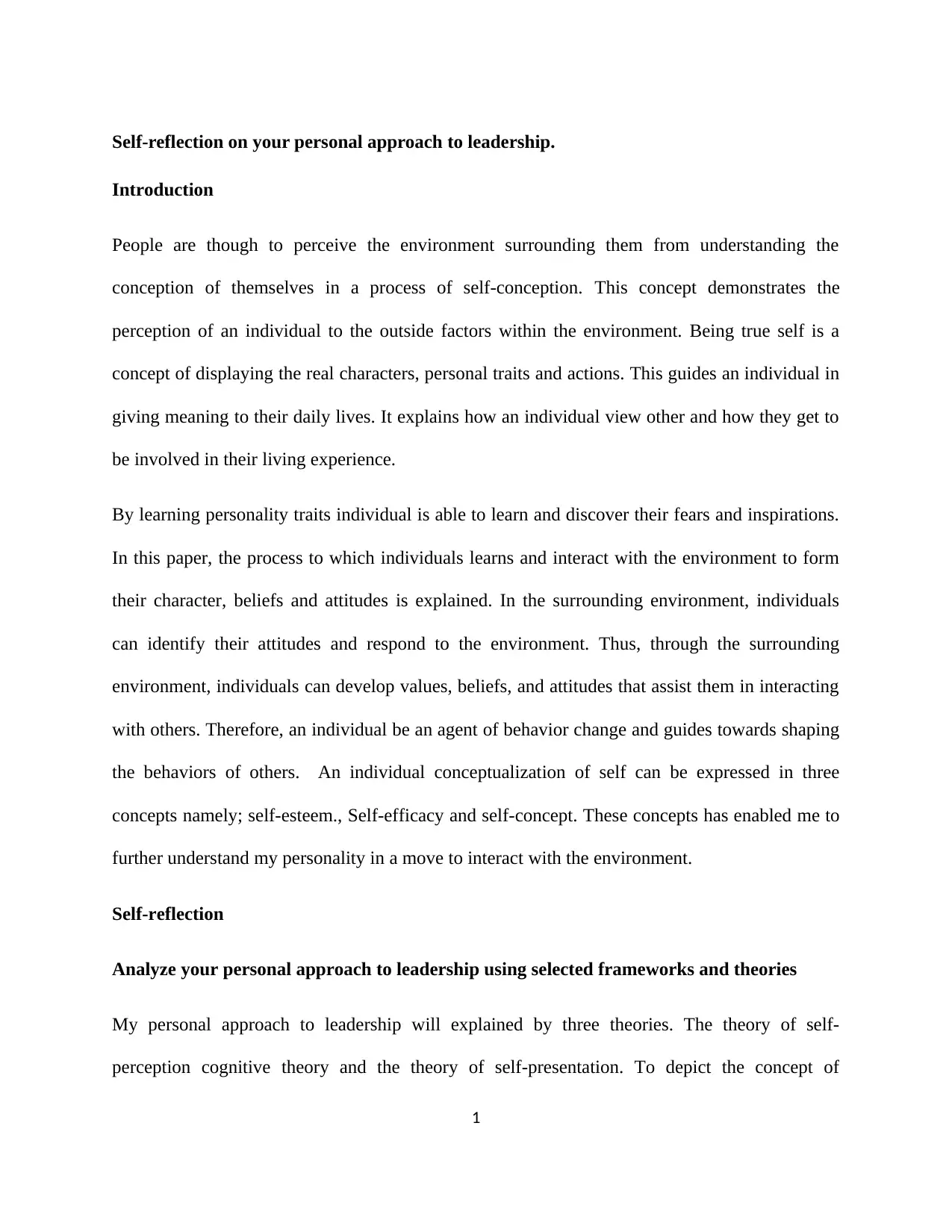
Self-reflection on your personal approach to leadership.
Introduction
People are though to perceive the environment surrounding them from understanding the
conception of themselves in a process of self-conception. This concept demonstrates the
perception of an individual to the outside factors within the environment. Being true self is a
concept of displaying the real characters, personal traits and actions. This guides an individual in
giving meaning to their daily lives. It explains how an individual view other and how they get to
be involved in their living experience.
By learning personality traits individual is able to learn and discover their fears and inspirations.
In this paper, the process to which individuals learns and interact with the environment to form
their character, beliefs and attitudes is explained. In the surrounding environment, individuals
can identify their attitudes and respond to the environment. Thus, through the surrounding
environment, individuals can develop values, beliefs, and attitudes that assist them in interacting
with others. Therefore, an individual be an agent of behavior change and guides towards shaping
the behaviors of others. An individual conceptualization of self can be expressed in three
concepts namely; self-esteem., Self-efficacy and self-concept. These concepts has enabled me to
further understand my personality in a move to interact with the environment.
Self-reflection
Analyze your personal approach to leadership using selected frameworks and theories
My personal approach to leadership will explained by three theories. The theory of self-
perception cognitive theory and the theory of self-presentation. To depict the concept of
1
Introduction
People are though to perceive the environment surrounding them from understanding the
conception of themselves in a process of self-conception. This concept demonstrates the
perception of an individual to the outside factors within the environment. Being true self is a
concept of displaying the real characters, personal traits and actions. This guides an individual in
giving meaning to their daily lives. It explains how an individual view other and how they get to
be involved in their living experience.
By learning personality traits individual is able to learn and discover their fears and inspirations.
In this paper, the process to which individuals learns and interact with the environment to form
their character, beliefs and attitudes is explained. In the surrounding environment, individuals
can identify their attitudes and respond to the environment. Thus, through the surrounding
environment, individuals can develop values, beliefs, and attitudes that assist them in interacting
with others. Therefore, an individual be an agent of behavior change and guides towards shaping
the behaviors of others. An individual conceptualization of self can be expressed in three
concepts namely; self-esteem., Self-efficacy and self-concept. These concepts has enabled me to
further understand my personality in a move to interact with the environment.
Self-reflection
Analyze your personal approach to leadership using selected frameworks and theories
My personal approach to leadership will explained by three theories. The theory of self-
perception cognitive theory and the theory of self-presentation. To depict the concept of
1
Paraphrase This Document
Need a fresh take? Get an instant paraphrase of this document with our AI Paraphraser
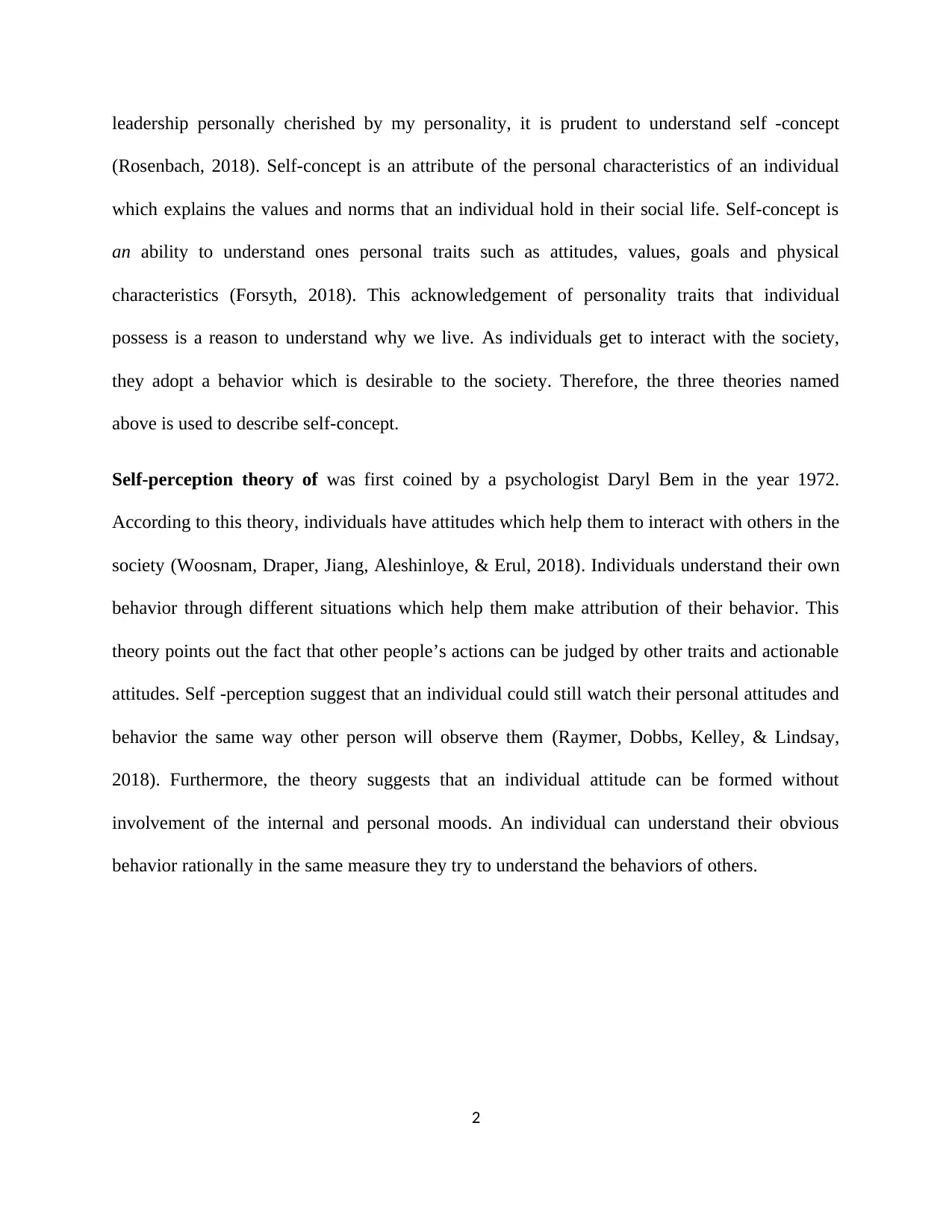
leadership personally cherished by my personality, it is prudent to understand self -concept
(Rosenbach, 2018). Self-concept is an attribute of the personal characteristics of an individual
which explains the values and norms that an individual hold in their social life. Self-concept is
an ability to understand ones personal traits such as attitudes, values, goals and physical
characteristics (Forsyth, 2018). This acknowledgement of personality traits that individual
possess is a reason to understand why we live. As individuals get to interact with the society,
they adopt a behavior which is desirable to the society. Therefore, the three theories named
above is used to describe self-concept.
Self-perception theory of was first coined by a psychologist Daryl Bem in the year 1972.
According to this theory, individuals have attitudes which help them to interact with others in the
society (Woosnam, Draper, Jiang, Aleshinloye, & Erul, 2018). Individuals understand their own
behavior through different situations which help them make attribution of their behavior. This
theory points out the fact that other people’s actions can be judged by other traits and actionable
attitudes. Self -perception suggest that an individual could still watch their personal attitudes and
behavior the same way other person will observe them (Raymer, Dobbs, Kelley, & Lindsay,
2018). Furthermore, the theory suggests that an individual attitude can be formed without
involvement of the internal and personal moods. An individual can understand their obvious
behavior rationally in the same measure they try to understand the behaviors of others.
2
(Rosenbach, 2018). Self-concept is an attribute of the personal characteristics of an individual
which explains the values and norms that an individual hold in their social life. Self-concept is
an ability to understand ones personal traits such as attitudes, values, goals and physical
characteristics (Forsyth, 2018). This acknowledgement of personality traits that individual
possess is a reason to understand why we live. As individuals get to interact with the society,
they adopt a behavior which is desirable to the society. Therefore, the three theories named
above is used to describe self-concept.
Self-perception theory of was first coined by a psychologist Daryl Bem in the year 1972.
According to this theory, individuals have attitudes which help them to interact with others in the
society (Woosnam, Draper, Jiang, Aleshinloye, & Erul, 2018). Individuals understand their own
behavior through different situations which help them make attribution of their behavior. This
theory points out the fact that other people’s actions can be judged by other traits and actionable
attitudes. Self -perception suggest that an individual could still watch their personal attitudes and
behavior the same way other person will observe them (Raymer, Dobbs, Kelley, & Lindsay,
2018). Furthermore, the theory suggests that an individual attitude can be formed without
involvement of the internal and personal moods. An individual can understand their obvious
behavior rationally in the same measure they try to understand the behaviors of others.
2
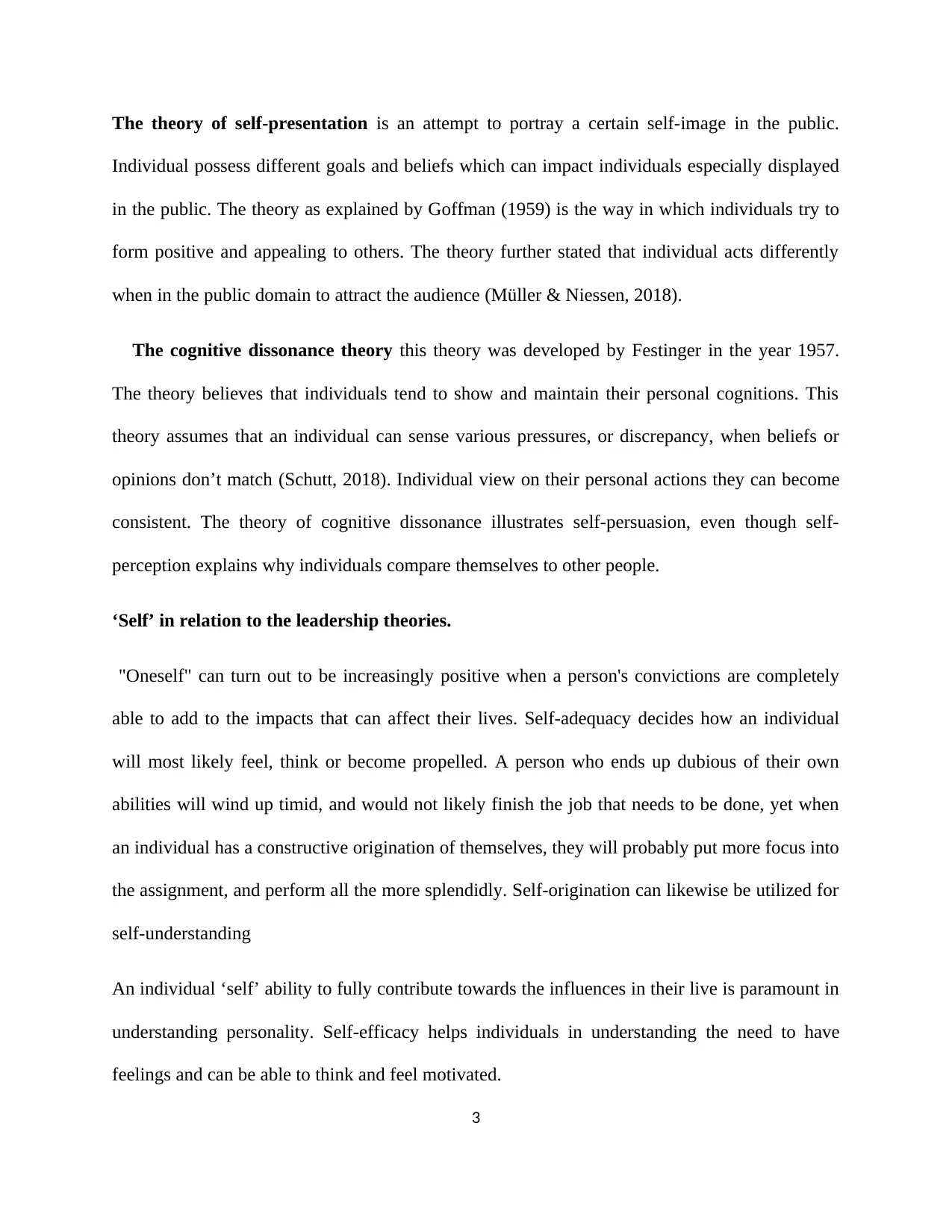
The theory of self-presentation is an attempt to portray a certain self-image in the public.
Individual possess different goals and beliefs which can impact individuals especially displayed
in the public. The theory as explained by Goffman (1959) is the way in which individuals try to
form positive and appealing to others. The theory further stated that individual acts differently
when in the public domain to attract the audience (Müller & Niessen, 2018).
The cognitive dissonance theory this theory was developed by Festinger in the year 1957.
The theory believes that individuals tend to show and maintain their personal cognitions. This
theory assumes that an individual can sense various pressures, or discrepancy, when beliefs or
opinions don’t match (Schutt, 2018). Individual view on their personal actions they can become
consistent. The theory of cognitive dissonance illustrates self-persuasion, even though self-
perception explains why individuals compare themselves to other people.
‘Self’ in relation to the leadership theories.
"Oneself" can turn out to be increasingly positive when a person's convictions are completely
able to add to the impacts that can affect their lives. Self-adequacy decides how an individual
will most likely feel, think or become propelled. A person who ends up dubious of their own
abilities will wind up timid, and would not likely finish the job that needs to be done, yet when
an individual has a constructive origination of themselves, they will probably put more focus into
the assignment, and perform all the more splendidly. Self-origination can likewise be utilized for
self-understanding
An individual ‘self’ ability to fully contribute towards the influences in their live is paramount in
understanding personality. Self-efficacy helps individuals in understanding the need to have
feelings and can be able to think and feel motivated.
3
Individual possess different goals and beliefs which can impact individuals especially displayed
in the public. The theory as explained by Goffman (1959) is the way in which individuals try to
form positive and appealing to others. The theory further stated that individual acts differently
when in the public domain to attract the audience (Müller & Niessen, 2018).
The cognitive dissonance theory this theory was developed by Festinger in the year 1957.
The theory believes that individuals tend to show and maintain their personal cognitions. This
theory assumes that an individual can sense various pressures, or discrepancy, when beliefs or
opinions don’t match (Schutt, 2018). Individual view on their personal actions they can become
consistent. The theory of cognitive dissonance illustrates self-persuasion, even though self-
perception explains why individuals compare themselves to other people.
‘Self’ in relation to the leadership theories.
"Oneself" can turn out to be increasingly positive when a person's convictions are completely
able to add to the impacts that can affect their lives. Self-adequacy decides how an individual
will most likely feel, think or become propelled. A person who ends up dubious of their own
abilities will wind up timid, and would not likely finish the job that needs to be done, yet when
an individual has a constructive origination of themselves, they will probably put more focus into
the assignment, and perform all the more splendidly. Self-origination can likewise be utilized for
self-understanding
An individual ‘self’ ability to fully contribute towards the influences in their live is paramount in
understanding personality. Self-efficacy helps individuals in understanding the need to have
feelings and can be able to think and feel motivated.
3
⊘ This is a preview!⊘
Do you want full access?
Subscribe today to unlock all pages.

Trusted by 1+ million students worldwide
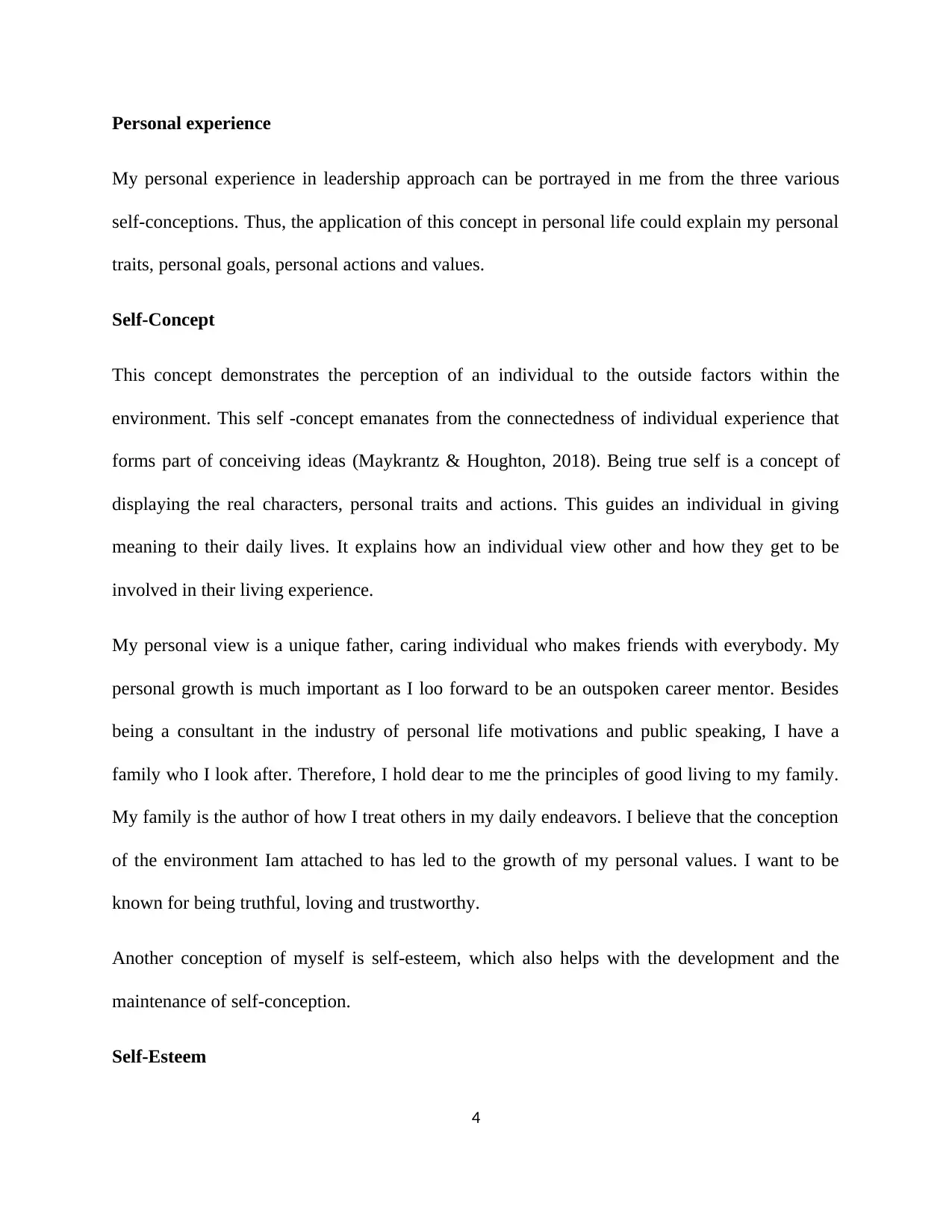
Personal experience
My personal experience in leadership approach can be portrayed in me from the three various
self-conceptions. Thus, the application of this concept in personal life could explain my personal
traits, personal goals, personal actions and values.
Self-Concept
This concept demonstrates the perception of an individual to the outside factors within the
environment. This self -concept emanates from the connectedness of individual experience that
forms part of conceiving ideas (Maykrantz & Houghton, 2018). Being true self is a concept of
displaying the real characters, personal traits and actions. This guides an individual in giving
meaning to their daily lives. It explains how an individual view other and how they get to be
involved in their living experience.
My personal view is a unique father, caring individual who makes friends with everybody. My
personal growth is much important as I loo forward to be an outspoken career mentor. Besides
being a consultant in the industry of personal life motivations and public speaking, I have a
family who I look after. Therefore, I hold dear to me the principles of good living to my family.
My family is the author of how I treat others in my daily endeavors. I believe that the conception
of the environment Iam attached to has led to the growth of my personal values. I want to be
known for being truthful, loving and trustworthy.
Another conception of myself is self-esteem, which also helps with the development and the
maintenance of self-conception.
Self-Esteem
4
My personal experience in leadership approach can be portrayed in me from the three various
self-conceptions. Thus, the application of this concept in personal life could explain my personal
traits, personal goals, personal actions and values.
Self-Concept
This concept demonstrates the perception of an individual to the outside factors within the
environment. This self -concept emanates from the connectedness of individual experience that
forms part of conceiving ideas (Maykrantz & Houghton, 2018). Being true self is a concept of
displaying the real characters, personal traits and actions. This guides an individual in giving
meaning to their daily lives. It explains how an individual view other and how they get to be
involved in their living experience.
My personal view is a unique father, caring individual who makes friends with everybody. My
personal growth is much important as I loo forward to be an outspoken career mentor. Besides
being a consultant in the industry of personal life motivations and public speaking, I have a
family who I look after. Therefore, I hold dear to me the principles of good living to my family.
My family is the author of how I treat others in my daily endeavors. I believe that the conception
of the environment Iam attached to has led to the growth of my personal values. I want to be
known for being truthful, loving and trustworthy.
Another conception of myself is self-esteem, which also helps with the development and the
maintenance of self-conception.
Self-Esteem
4
Paraphrase This Document
Need a fresh take? Get an instant paraphrase of this document with our AI Paraphraser
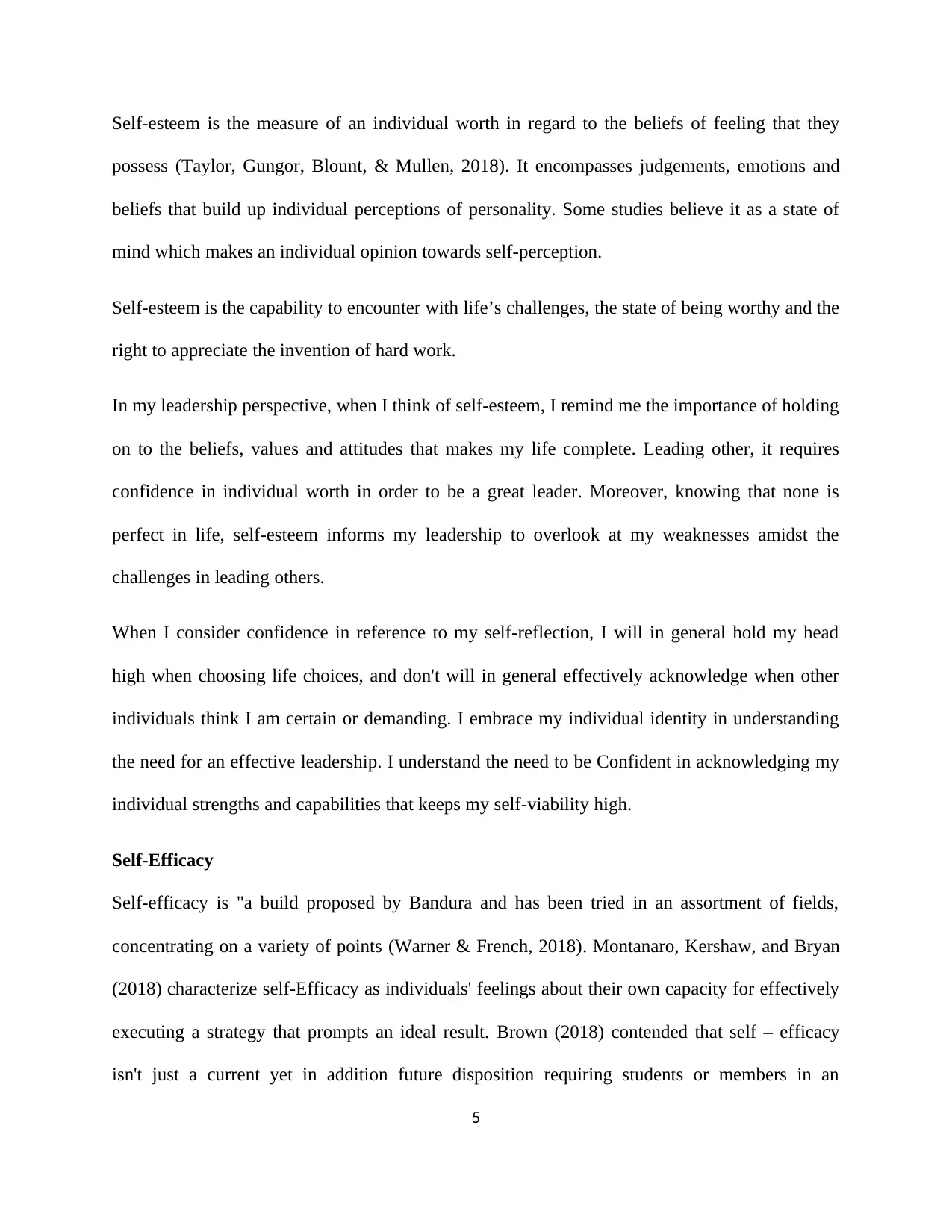
Self-esteem is the measure of an individual worth in regard to the beliefs of feeling that they
possess (Taylor, Gungor, Blount, & Mullen, 2018). It encompasses judgements, emotions and
beliefs that build up individual perceptions of personality. Some studies believe it as a state of
mind which makes an individual opinion towards self-perception.
Self-esteem is the capability to encounter with life’s challenges, the state of being worthy and the
right to appreciate the invention of hard work.
In my leadership perspective, when I think of self-esteem, I remind me the importance of holding
on to the beliefs, values and attitudes that makes my life complete. Leading other, it requires
confidence in individual worth in order to be a great leader. Moreover, knowing that none is
perfect in life, self-esteem informs my leadership to overlook at my weaknesses amidst the
challenges in leading others.
When I consider confidence in reference to my self-reflection, I will in general hold my head
high when choosing life choices, and don't will in general effectively acknowledge when other
individuals think I am certain or demanding. I embrace my individual identity in understanding
the need for an effective leadership. I understand the need to be Confident in acknowledging my
individual strengths and capabilities that keeps my self-viability high.
Self-Efficacy
Self-efficacy is "a build proposed by Bandura and has been tried in an assortment of fields,
concentrating on a variety of points (Warner & French, 2018). Montanaro, Kershaw, and Bryan
(2018) characterize self-Efficacy as individuals' feelings about their own capacity for effectively
executing a strategy that prompts an ideal result. Brown (2018) contended that self – efficacy
isn't just a current yet in addition future disposition requiring students or members in an
5
possess (Taylor, Gungor, Blount, & Mullen, 2018). It encompasses judgements, emotions and
beliefs that build up individual perceptions of personality. Some studies believe it as a state of
mind which makes an individual opinion towards self-perception.
Self-esteem is the capability to encounter with life’s challenges, the state of being worthy and the
right to appreciate the invention of hard work.
In my leadership perspective, when I think of self-esteem, I remind me the importance of holding
on to the beliefs, values and attitudes that makes my life complete. Leading other, it requires
confidence in individual worth in order to be a great leader. Moreover, knowing that none is
perfect in life, self-esteem informs my leadership to overlook at my weaknesses amidst the
challenges in leading others.
When I consider confidence in reference to my self-reflection, I will in general hold my head
high when choosing life choices, and don't will in general effectively acknowledge when other
individuals think I am certain or demanding. I embrace my individual identity in understanding
the need for an effective leadership. I understand the need to be Confident in acknowledging my
individual strengths and capabilities that keeps my self-viability high.
Self-Efficacy
Self-efficacy is "a build proposed by Bandura and has been tried in an assortment of fields,
concentrating on a variety of points (Warner & French, 2018). Montanaro, Kershaw, and Bryan
(2018) characterize self-Efficacy as individuals' feelings about their own capacity for effectively
executing a strategy that prompts an ideal result. Brown (2018) contended that self – efficacy
isn't just a current yet in addition future disposition requiring students or members in an
5
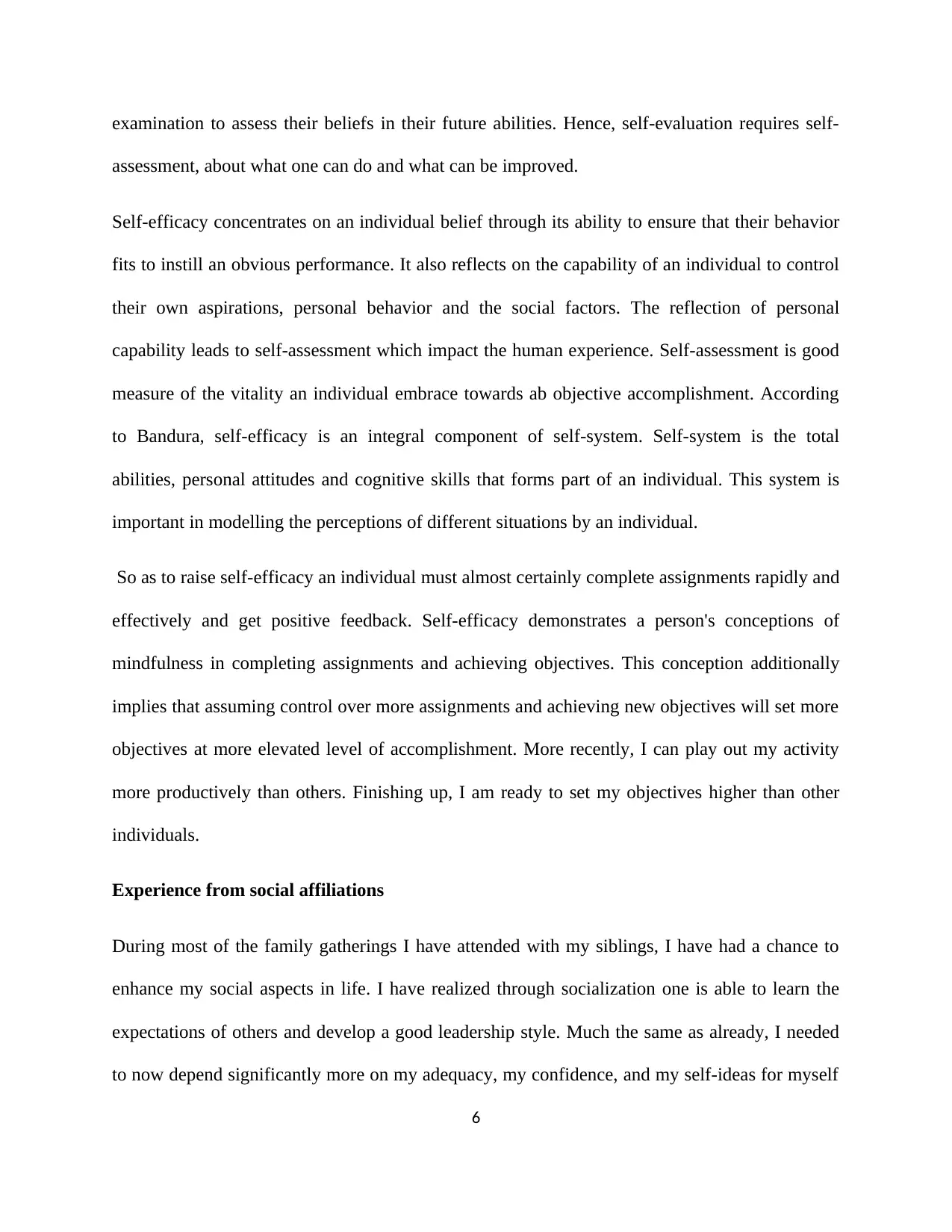
examination to assess their beliefs in their future abilities. Hence, self-evaluation requires self-
assessment, about what one can do and what can be improved.
Self-efficacy concentrates on an individual belief through its ability to ensure that their behavior
fits to instill an obvious performance. It also reflects on the capability of an individual to control
their own aspirations, personal behavior and the social factors. The reflection of personal
capability leads to self-assessment which impact the human experience. Self-assessment is good
measure of the vitality an individual embrace towards ab objective accomplishment. According
to Bandura, self-efficacy is an integral component of self-system. Self-system is the total
abilities, personal attitudes and cognitive skills that forms part of an individual. This system is
important in modelling the perceptions of different situations by an individual.
So as to raise self-efficacy an individual must almost certainly complete assignments rapidly and
effectively and get positive feedback. Self-efficacy demonstrates a person's conceptions of
mindfulness in completing assignments and achieving objectives. This conception additionally
implies that assuming control over more assignments and achieving new objectives will set more
objectives at more elevated level of accomplishment. More recently, I can play out my activity
more productively than others. Finishing up, I am ready to set my objectives higher than other
individuals.
Experience from social affiliations
During most of the family gatherings I have attended with my siblings, I have had a chance to
enhance my social aspects in life. I have realized through socialization one is able to learn the
expectations of others and develop a good leadership style. Much the same as already, I needed
to now depend significantly more on my adequacy, my confidence, and my self-ideas for myself
6
assessment, about what one can do and what can be improved.
Self-efficacy concentrates on an individual belief through its ability to ensure that their behavior
fits to instill an obvious performance. It also reflects on the capability of an individual to control
their own aspirations, personal behavior and the social factors. The reflection of personal
capability leads to self-assessment which impact the human experience. Self-assessment is good
measure of the vitality an individual embrace towards ab objective accomplishment. According
to Bandura, self-efficacy is an integral component of self-system. Self-system is the total
abilities, personal attitudes and cognitive skills that forms part of an individual. This system is
important in modelling the perceptions of different situations by an individual.
So as to raise self-efficacy an individual must almost certainly complete assignments rapidly and
effectively and get positive feedback. Self-efficacy demonstrates a person's conceptions of
mindfulness in completing assignments and achieving objectives. This conception additionally
implies that assuming control over more assignments and achieving new objectives will set more
objectives at more elevated level of accomplishment. More recently, I can play out my activity
more productively than others. Finishing up, I am ready to set my objectives higher than other
individuals.
Experience from social affiliations
During most of the family gatherings I have attended with my siblings, I have had a chance to
enhance my social aspects in life. I have realized through socialization one is able to learn the
expectations of others and develop a good leadership style. Much the same as already, I needed
to now depend significantly more on my adequacy, my confidence, and my self-ideas for myself
6
⊘ This is a preview!⊘
Do you want full access?
Subscribe today to unlock all pages.

Trusted by 1+ million students worldwide
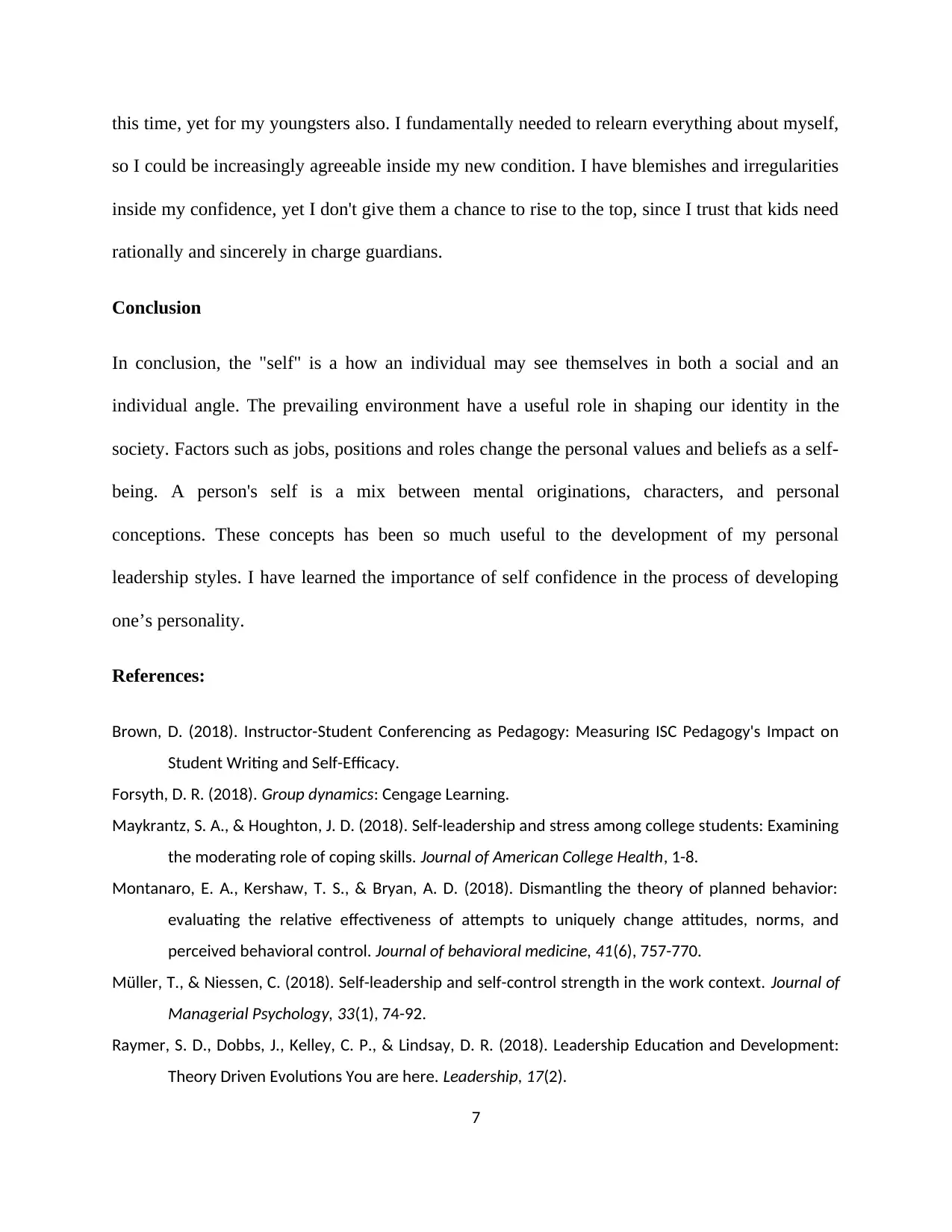
this time, yet for my youngsters also. I fundamentally needed to relearn everything about myself,
so I could be increasingly agreeable inside my new condition. I have blemishes and irregularities
inside my confidence, yet I don't give them a chance to rise to the top, since I trust that kids need
rationally and sincerely in charge guardians.
Conclusion
In conclusion, the "self" is a how an individual may see themselves in both a social and an
individual angle. The prevailing environment have a useful role in shaping our identity in the
society. Factors such as jobs, positions and roles change the personal values and beliefs as a self-
being. A person's self is a mix between mental originations, characters, and personal
conceptions. These concepts has been so much useful to the development of my personal
leadership styles. I have learned the importance of self confidence in the process of developing
one’s personality.
References:
Brown, D. (2018). Instructor-Student Conferencing as Pedagogy: Measuring ISC Pedagogy's Impact on
Student Writing and Self-Efficacy.
Forsyth, D. R. (2018). Group dynamics: Cengage Learning.
Maykrantz, S. A., & Houghton, J. D. (2018). Self-leadership and stress among college students: Examining
the moderating role of coping skills. Journal of American College Health, 1-8.
Montanaro, E. A., Kershaw, T. S., & Bryan, A. D. (2018). Dismantling the theory of planned behavior:
evaluating the relative effectiveness of attempts to uniquely change attitudes, norms, and
perceived behavioral control. Journal of behavioral medicine, 41(6), 757-770.
Müller, T., & Niessen, C. (2018). Self-leadership and self-control strength in the work context. Journal of
Managerial Psychology, 33(1), 74-92.
Raymer, S. D., Dobbs, J., Kelley, C. P., & Lindsay, D. R. (2018). Leadership Education and Development:
Theory Driven Evolutions You are here. Leadership, 17(2).
7
so I could be increasingly agreeable inside my new condition. I have blemishes and irregularities
inside my confidence, yet I don't give them a chance to rise to the top, since I trust that kids need
rationally and sincerely in charge guardians.
Conclusion
In conclusion, the "self" is a how an individual may see themselves in both a social and an
individual angle. The prevailing environment have a useful role in shaping our identity in the
society. Factors such as jobs, positions and roles change the personal values and beliefs as a self-
being. A person's self is a mix between mental originations, characters, and personal
conceptions. These concepts has been so much useful to the development of my personal
leadership styles. I have learned the importance of self confidence in the process of developing
one’s personality.
References:
Brown, D. (2018). Instructor-Student Conferencing as Pedagogy: Measuring ISC Pedagogy's Impact on
Student Writing and Self-Efficacy.
Forsyth, D. R. (2018). Group dynamics: Cengage Learning.
Maykrantz, S. A., & Houghton, J. D. (2018). Self-leadership and stress among college students: Examining
the moderating role of coping skills. Journal of American College Health, 1-8.
Montanaro, E. A., Kershaw, T. S., & Bryan, A. D. (2018). Dismantling the theory of planned behavior:
evaluating the relative effectiveness of attempts to uniquely change attitudes, norms, and
perceived behavioral control. Journal of behavioral medicine, 41(6), 757-770.
Müller, T., & Niessen, C. (2018). Self-leadership and self-control strength in the work context. Journal of
Managerial Psychology, 33(1), 74-92.
Raymer, S. D., Dobbs, J., Kelley, C. P., & Lindsay, D. R. (2018). Leadership Education and Development:
Theory Driven Evolutions You are here. Leadership, 17(2).
7
Paraphrase This Document
Need a fresh take? Get an instant paraphrase of this document with our AI Paraphraser
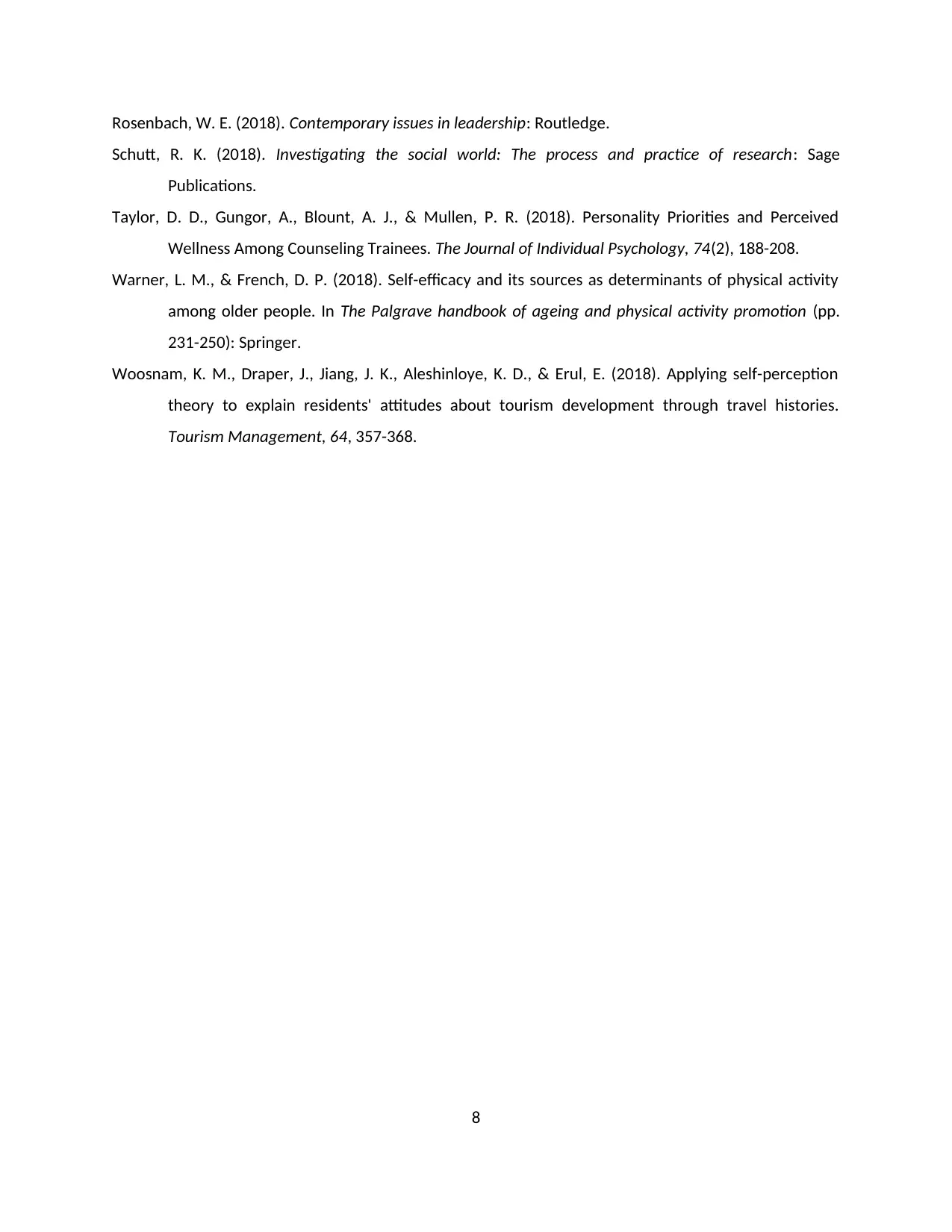
Rosenbach, W. E. (2018). Contemporary issues in leadership: Routledge.
Schutt, R. K. (2018). Investigating the social world: The process and practice of research: Sage
Publications.
Taylor, D. D., Gungor, A., Blount, A. J., & Mullen, P. R. (2018). Personality Priorities and Perceived
Wellness Among Counseling Trainees. The Journal of Individual Psychology, 74(2), 188-208.
Warner, L. M., & French, D. P. (2018). Self-efficacy and its sources as determinants of physical activity
among older people. In The Palgrave handbook of ageing and physical activity promotion (pp.
231-250): Springer.
Woosnam, K. M., Draper, J., Jiang, J. K., Aleshinloye, K. D., & Erul, E. (2018). Applying self-perception
theory to explain residents' attitudes about tourism development through travel histories.
Tourism Management, 64, 357-368.
8
Schutt, R. K. (2018). Investigating the social world: The process and practice of research: Sage
Publications.
Taylor, D. D., Gungor, A., Blount, A. J., & Mullen, P. R. (2018). Personality Priorities and Perceived
Wellness Among Counseling Trainees. The Journal of Individual Psychology, 74(2), 188-208.
Warner, L. M., & French, D. P. (2018). Self-efficacy and its sources as determinants of physical activity
among older people. In The Palgrave handbook of ageing and physical activity promotion (pp.
231-250): Springer.
Woosnam, K. M., Draper, J., Jiang, J. K., Aleshinloye, K. D., & Erul, E. (2018). Applying self-perception
theory to explain residents' attitudes about tourism development through travel histories.
Tourism Management, 64, 357-368.
8
1 out of 8
Related Documents
Your All-in-One AI-Powered Toolkit for Academic Success.
+13062052269
info@desklib.com
Available 24*7 on WhatsApp / Email
![[object Object]](/_next/static/media/star-bottom.7253800d.svg)
Unlock your academic potential
Copyright © 2020–2025 A2Z Services. All Rights Reserved. Developed and managed by ZUCOL.





